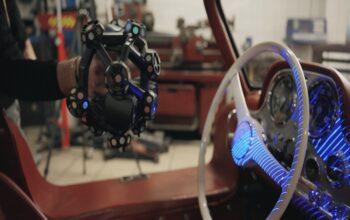
NVIDIA Server Rack Inspection
As a manufacturer of networking solutions, companies rely on NVIDIA for quick connectivity to switching units that operate around the clock to access their many devices.
To ensure that NVIDIA’s high-end and complex systems operate exactly as intended, inspection is crucial. Production operators need to look for damage in connectors before systems leave the manufacturing plant. Until recently, fielding an automated system capable of inspecting thousands of points took months, if it was possible at all. For this reason, quality control was done manually at NVIDIA’s subcontractor plant, until the company learned about a Kitov solution, which was able to automate the visual inspection task quickly and cost-effectively. The resulting test plan combines traditional 2D and 3D machine vision capabilities with powerful deep learning (DL) software and automatic robotic path planning.
The Challenge of Inspecting Complex Systems
The NVIDIA Director Switch networking system includes hundreds of connectors used to communicate between devices in a company’s network. The system essentially acts as a large switch that manages the flow of data across an enterprise network through the use of multiple connectors that tie together a company’s devices.

With so many tiny connectors located in hard-to-reach places, ensuring that each connector and its pins are located correctly and are free of obstruction is challenging for human inspectors. They have to shine flashlights inside server racks to look for bent pins, broken frames, and foreign objects. Flaws can include parts with plastic injection molding material or other contaminants attached, and bent or missing connectors and pins — all of which can affect how a unit operates.
Manual inspection seems even more daunting when you consider that each system contains nearly 380 connectors and that each connector includes 40 pins. These parts are small, with a connector measuring 50 × 45 millimeters and a pin frame measuring 4 × 7.5 millimeters.
As a manufacturer of networking solutions, companies rely on NVIDIA for quick connectivity to switching units that operate around the clock to access their many devices.
Because the cost for each switch is extremely high, buyers need such systems to work from the get-go. They can’t afford to have network downtime due to faulty switching systems. With the inspection of tiny parts being so complex and time-consuming, and with human inspectors who make mistakes, NVIDIA knew it had the potential to improve the process with an automated solution.

NVIDIA sought a solution that could reduce part failure and recalls, and cut inspection time, which would in turn reduce costs across production and supply chains. In addition, the desired solution should easily adapt to modifications made to the switch, and to future versions and models. The system contains 1,024 communication ports that are kept cool using an internal water-cooling solution. This makes the assembly process complex, with total assembly taking about one week. The midplane is produced at one plant and then delivered to a plant in Israel. Then mechanical parts are added, the system is fully assembled and tested, and quality inspection is performed.
With such a large (48.96 × 17.64 × 30.3 inches) and complex system, NVIDIA knew it would benefit from the data supplied by an automated visual inspection system and its ability to prevent faulty parts from being shipped.
After evaluating several options, NVIDIA chose Kitov.ai’s solution that combines intelligent robotic planning technologies, deep learning, 3D imaging, and novel algorithms to solve manufacturing’s most complex inspection applications. Kitov.ai’s solution includes a custom optical head comprised of a camera and custom lights; and a K-Box, Kitov’s processing unit, running the Kitov Smart Planner and Inspection software, which includes both traditional 2D and 3D machine vision as well as deep learning capabilities.
Kitov Smart Planner software also includes Kitov.ai’s award-winning CAD2SCAN functionality, which automatically optimizes machine vision inspection best practices and robotic path planning based on the target parts CAD files, supporting leading CAD software systems and the new ISO QIF (Quality Information Framework) standard. Kitov software also includes “semantic detectors,” or custom algorithms designed to solve specific tasks, such as inspecting all aspects of a screw or other fastener, electronic port inspection, and other common tasks.
NVIDIA was able to train the system and maximize its performance for the complex inspection routine in only a few weeks. Kitov’s software, which includes AI/deep learning capability, also improves over time by learning to differentiate between actual failures and minor issues that don’t affect the connectors and are not considered failures.
Operators set up and edit inspection plans for the Director Switch with Kitov software, which allows for robot path planning and inspection without computationally intensive AI/DL training. The software automatically includes production tolerance values from the CAD/QIF files or from a 3D digital twin model of the product generated by the Kitov system.

Testing previously involved comparing inspection results from human inspectors to a machine vision inspection of the same part. During this test, the company also simulated defects manually to see whether the system could detect common defects. The automated system had no issues with locating simulated defects.
To help with warranty claims, NVIDIA saves the actual images and the inspection results from each inspection in an archive. Should the manufacturer discover a defect, it can use the information returned by the system to make process improvements that prevent future defects.
NVIDIA has seen outstanding results. It slashed the time spent inspecting connectors and pins within the switch by 80% and has had no warranty claims since implementing the Kitov system.










